One of the things that I really like about Merida is its neighborhood markets.
The city's central market,Mercado Lucas de Galvez, covers a number of square blocks on the edge of the historic centro area and is riotous collage that confronts all five of one's senses.
One can find almost anything in the central market. More than once I have found something at the central market I had failed to locate elsewhere. When I determined I needed a mattock with which to excavate the back yard, unable to locate one in a number of the local hardware stores I checked the sprawling hardware store at the central market. I explained to one of the attendants what I was looking for, he consulted el jefe who disappeared into a narrow passageway that weaves through his floor to ceiling collection of wares. El jefe soon emerged with a smile, holding just what I had been searching for.
The Mercado Santa Ana is my neighborhood market which I visit at least twice each week. Here are a few of the vendors of the Santa Ana Market with whom I do business.
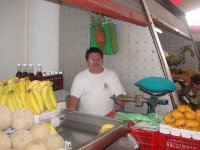

At the left is Luis Escalante and at right is Julia Bwas. Each Friday I buy a week's supply of fruit from Luis and vegetables from Julia. They both have come to expect me and greet me warmly.
At
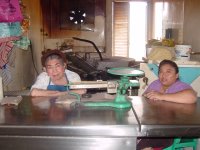
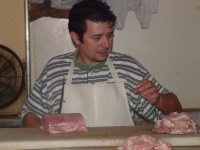 the left is Juan Cetina who speaks English quite well and cuts pork to order. At the right is Eloida Peraza, on the left, and Patricia Lizama from whom each week I buy piping hot corn tortillas fresh from their fifty year old machine that rolls, heats, and cuts tortillas from the masa harina they feed into the hopper.
the left is Juan Cetina who speaks English quite well and cuts pork to order. At the right is Eloida Peraza, on the left, and Patricia Lizama from whom each week I buy piping hot corn tortillas fresh from their fifty year old machine that rolls, heats, and cuts tortillas from the masa harina they feed into the hopper.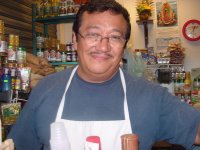
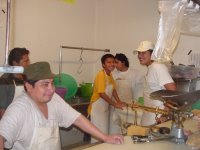
When I want chicken I see the guys on the left, who also cut to order. There is no extra charge for their incessant jesting. At right is Raphael Montejo, whose little stall is full to the brim with all manner of grocery items and his omnipresent smile.
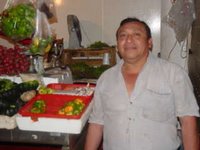

Alberto Lizama, at the left, and Manuel Munoz tend produce stalls just down from Luis'. The market houses quite a number of produce vendors and a few small groceries. There is a jeweler, a religious articles vendor and other odds and ends.

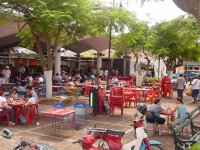
Jose Sanchez, at left, occupies a shoe repair booth. My two month old, street worn sandals in need of new soles can be seen on his bench at his left elbow.
At the front of the market, facing the Parque Santa Ana, are a number of cocinas economicas. The cocinas share an outdoor seating area and music provided by folks who stop by to play and drum in hopes of donations for their efforts.
Parque Santa Ana, the center of the Santa Ana neighborhood, is a block square plaza, centered by a monument, the base of which is surrounded by a circular, elevated platform which serves as a stage for weekend musical performances and other events. The entire edifice is in turn surrounded by a shallow amphitheater. At the North edge of the park is a cathedral, the pealing bells of which I can hear from my apartment 4 blocks away, and on its West the park borders Calle 60, a primary North/South arterial.
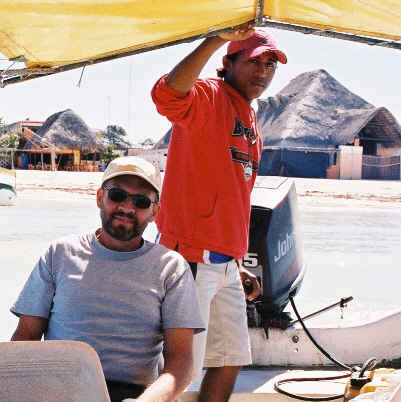
6 comments:
Thanks for the lesson, YNM-- it's clear that you really know your vendors... enough that they pose for pictures and smile. And now I know where to go for fresh flour tortillas-- woohoo!
Actually, those are corn tortillas that their ancient machine cranks out. I was there today and the machine was cranking, emanating all of its noise and heat.
They also have a machine that grinds the corn and deposits large globs of wet masa harina into a bin from which big globs are lifted and placed on a table next to the bin of the tortilla machine.
When I ask for tortillas they ask how many, so I hold my fingers apart to indicate a stack of about 10 or 15. They slap them on the scale and tell me I owe them about 5 pseos.
Actually, I had intended to take pictures of those with whom I regularly do business, but as soon as I took my camera out my regulars directed me to others that I should photograph.
It's certainly a completely different experience, and I think far superior, from going to the grocery store in the USA.
That's funny about the photos... designated photogenics, I guess.
I knew my flour tortilla dream was too good to be true... so, not to split Spanish hairs, but that would be masa de elote, no?
Speaking of which, I broke down and went to the often pooh-poohed Restaurante Los Almendros today (pooh poohed in a couple of tourist guides, anyway, as somehow too popular and not that great). They had wonderful fresh corn tortillas, tastier than many I've had, and excellent pavo en relleno negro. I was tempted to order the frijol con puerco, but I'm still coming down from my high of several weeks ago...
But tomorrow is another day, and with it comes... carne!
When it comes to the Spanish language I certainly bow to your superior knowledge. Aun estoy aprendiendo. Upon further review the dough the tortilla ladies feed into their growling machine is considered masa. Masa harina is the powdered masa one buys in bags at the store. To further belabor the subject my dictionary idicates that corn meal, which is different than masa which is from corn boiled in lime, is harina de maiz.
Indeed, carne argentino.
yikes, don't bow to *my* Spanish-- I'm wrong more often than right! As proven... the whole masa conversation still has me spinning. Pues. Siempre aprendiendo, siempre.
This link leads to a comprehensive discussion of masa and masa harina. It evens explains how to make masa, should you be so moved.
http://www.zarela.com/new_recipes/nixtamal.html
Post a Comment